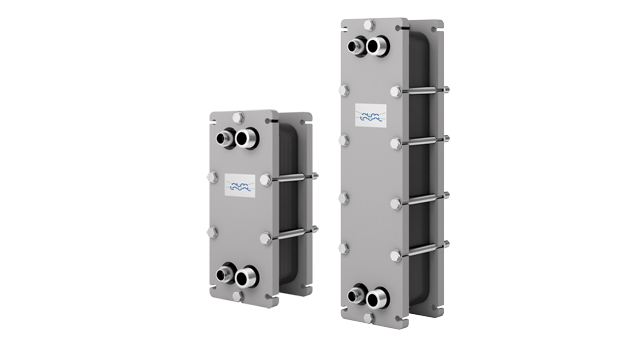AXP AN
AXP stands for “extreme pressure,” and that’s exactly what this line of AlfaNova heat exchangers are designed to handle. Specifically engineered for subcritical and transcritical applications with CO2, the 100% stainless steel design also enables possibilities for other high-pressure duties with high hygiene demands or aggressive media. AlfaNova is therefore suited to CO2/ammonia cascade systems or compressor cooling.
Sustainable Heat Transfer
- Highly resistant to corrosion and extreme pressures
- Ensures a low refrigerant volume for ammonia systems where a low charge is desirable
- Can reliably support media temperatures ranging from -196°C (-320.8°F) to 550°C (1022°F)
- Able to withstand extremely high operating pressures thanks to external frames in carbon steel
- Certified to handle pressures up to 110 bar (PED approval) and 1595 psi (UL approval)
Unique features to boost your performance
With more than 80 years of experience in heat transfer innovation, Alfa Laval knows what it takes to deliver high-performance solutions for any application. Our experts continuously develop new innovations that give our AlfaNova AXP line of heat exchangers more reliable and efficient performance.
AlfaNova®
100% stainless steel
Built with 100% stainless steel, AlfaNova® is a solution that Alfa Laval offers for applications that use media not compatible with traditional heat exchanger materials. Not only is this advanced design optimized for use with natural refrigerants, it’s also completely recyclable.
PressureSecure
Unparalleled strength for demanding duties
Our innovative plate designs support the widest range of high-temperature and high-pressure applications. Units can run using thinner plates and fewer plates, which translates to less raw material, lower energy consumption, reduced refrigerant charge and a longer equipment lifecycle.
REFuture
A future-proof investment for tomorrow’s refrigerants
As an innovative driver in the development of solutions for natural refrigerants, Alfa Laval brings years of experience working with products that enable the use of new-generation and low-GWP refrigerants to help you meet sustainability goals and any legislative requirements.
Finding the right heat exchanger
With expertise from decades of experience in heat exchange, Alfa Laval offers guidance and useful tools to help you meet today’s heating and cooling challenges. Our product guide is an interactive resource you can use to find the ideal solution for your application.

Contact us
Do you have questions about our portfolio of brazed and fusion bonded plate heat exchangers? We can work with you to find the optimal model to fit your specific needs.

